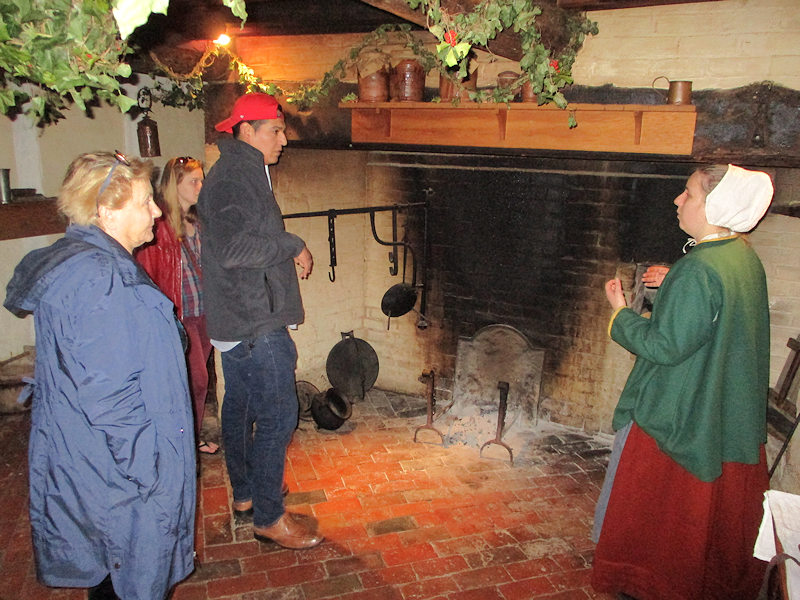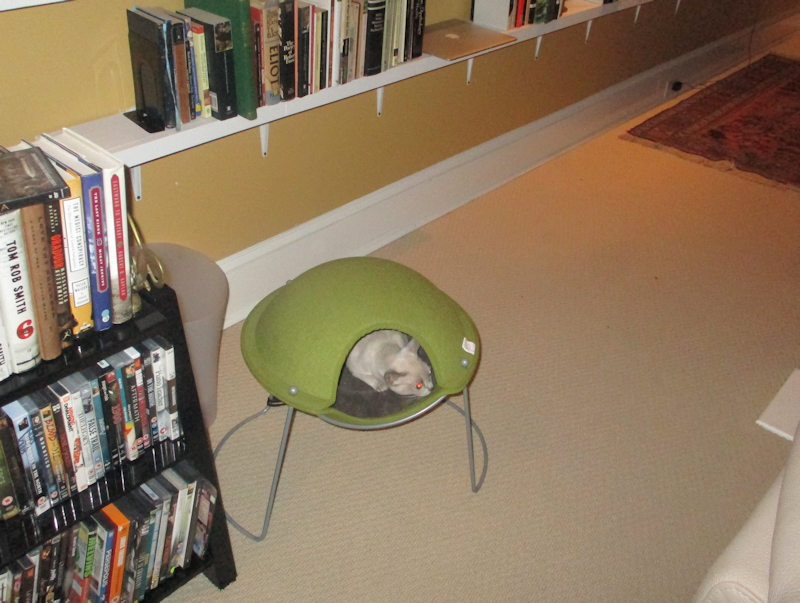You may not find this terribly rewarding unless you're included here, so this is a good time for casual and random browsers to turn back before they get too caught up in the sweep and majesty of the proceedings and can't let go.
Back to the Frontier Culture Museum, 29 December 2019

On a chilly and rainy (and, soon, raining) day, we're introducing Emily and Clinton to the wonders of Staunton's Frontier Culture Museum.

This is the West African village -- the idea of the Museum is to demonstrate something of the frontier life of the ethnic and cultural groups that made up the settler populations of western Virginia, back in the day. We'll soon circulate through the exhibits based on the English, German, northern Irish immigrants (all Protestants, mostly) who chose to start new lives here, but whom better to start with than the West African villagers who didn't get a choice.

Clinton contemplating the goods in the community hall; when we were here a few weeks ago, we got lessons in West African drumming (by a docent from Burundi), but we're on our own today.

The Museum is well provided with information plaques and volunteer and professional docents to explain the exhibits and their contexts, but we've visited several times recently and won't repeat our brief photo captions now. It's recommended to come here and read the plaques and quiz the interpretation staff in person, but in the meantime, there's no prohibition against viewing our captions here: 3 May 2019, 13 October 2019, and 29 October.

We proceed to the English house . . .

. . . with a pause to photograph the tiny goats. The information provided by the Museum includes, not only context about the lives of the people back then, but importantly about their contributions to the emerging 'melting-pot' culture over time as well.

A fairly well-to-do farm family's house from the English midlands in the 17th century; the house was dismantled and transported here in numbered pieces for reassembly.

Typical homemade comestibles of the time and place

Explanations of the central role and uses of the fireplace

On to the 18th century Irish forge from County Fermanagh in Ulster . . .

. . . the most photogenic of the Museum's buildings; even on a grey day. On past visits, artisans were in there producing the iron work used throughout the Museum's exhibits and for sale in the gift shop as well. This is rather an off day for everybody.

The short cut . . .

. . . successfully negotiated

The Irish farm, from the 18th century in the northern, mostly Protestant province of Ulster

A look back at the forge

The Q & A period -- we've met three different expert docents in the Irish farm on our past visits, all very knowledgeable.

And a kitten to be petted

More photo opportunities

We can all recognize that look.

Trying for a close-up

The German farm, brought from the formerly-Protestant Palatinate on the Rhine

The farm house

A demonstration of an energy-efficient German cooking arrangement, sparing the need for logs for the fireplace. The last time we were here, this gentleman was playing 18th century German folk tunes on a homemade period stringed instrument.

That, by the way, is Sunshine.

The sheep charge in at any sign of attention.

Attention

This, with a nod to the pre-settlers of the region as well, is meant to represent a small Native American village, with information about the inhabitants' contributions to the emerging frontier culture (but no mention of the contributions of the Seven Years' War and Pontiac's War in the 1750s and '60s, grim work on all sides; here we're celebrating 'the hospitality, generosity, and cooperation of the American Indians of the continent's eastern coastal plain and woodlands').

Approaching the 1740s early settler's cabin, as the Heavens open up upon us. We knew it was coming.

Frontier brides about to be carried over the threshold were in for a real shock.

An open-plan interior

And a chimney of eccentric design

This, by the way, is Dalley (spelling uncertain).

We've passed the 1820s Shenandoah Valley farmhouse and proceeded directly to the period schoolhouse.

That, for the delectation of the eager young pupils, is a J. H. Colson map print, but the date is illegible in this photo.

Out on the I81 highway, Walmart never sleeps.

Moving on to the 1850s farmhouse, with a Target truck on the autostrada. (We prefer the French pronunciation: 'tar-jay'.)

First responders. Someone's having a bad day.

That, by the way, is 'Trouble'.

Approaching the 1850s Valley farmhouse, with informative accompaniment

The 1820s farm, the schoolhouse, a church up on the hill somewhere, a barn, a spring house, lots of odds and ends. And the Betsy Bell hill and 'Wilderness Park' in the background.

The 1820s house

And the much more luxurious 1850s house


Dodging raindrops back out to the entrance
More cats

Little Wednesday's got the flying saucer, and Choupette is impatient for her turn.

Choupette joins Wednesday in the flying saucer.

A stealth attack

Redistribution of occupants

Three occupants in one flying saucer

It wasn't working out.

-- Where did everyone go?

The end of a long day

Three cats (photo by Emily)

Goodbye to Wednesday, and to Pugsley too, and to their handlers.
31 December 2019; another one down.
Next stop: Sherando Lake and the Wintergreen Resort on New Year's Day


 Dwight Peck's personal website
Dwight Peck's personal website




















































